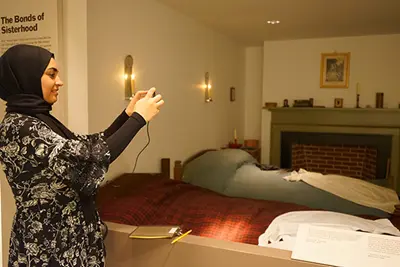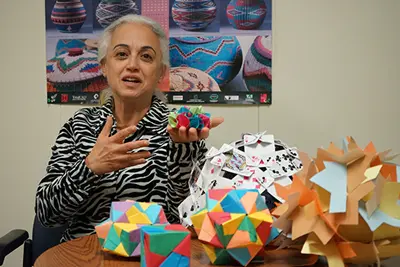International and Domestic Students Both Benefit from Popular OMA Program
 Image by Ed Brennen
Image by Ed Brennen
11/09/2018
By Ed Brennen
The 200 students in the room hailed from 32 countries and spoke 26 languages. There were 98 undergraduate students, 82 graduate students and 20 Ph.D. candidates. Two-thirds were international students and one-third were American.
Of all the events on campus each year, few capture the university’s commitment to diversity and multicultural learning quite like the Pair-Up Program’s annual meet-and-greet at University Crossing’s Moloney Ballroom.
Now in its fourth year, the Pair-Up Program fosters multicultural friendships by matching international and domestic students through mutual interests and majors. International students are able to connect with someone who can help them overcome language barriers and learn about their new campus and city, while domestic students increase their cultural understanding by engaging with people from different backgrounds.
 Image by Ed Brennen
Image by Ed Brennen
“It’s so heartwarming to see so much diversity in one room,” Allyson Lynch, coordinator of international programs for the OMA, said during the meet-and-greet event, which included a lively scavenger hunt throughout University Crossing. “These students are getting to see the world right here on our campus.”
Students are usually grouped in trios, with two international students and one domestic student. The groups are assigned to one of 10 student ambassadors, who were added to the program last year to help manage activities and answer questions.
Participants are required to attend a monthly meeting, which includes a group activity such as making a “dream catcher” as part of Native American Indian Heritage Month in November. The student groups are also required to attend at least one on-campus event each semester, such as a sporting event or art exhibit, and also meet monthly on their own, perhaps for coffee or lunch.
 Image by Ed Brennen
Image by Ed Brennen
A graduate student from India who is pursuing her M.S. in pharmaceutical sciences, Bhardwaj said the program has helped ease her transition to campus. “I haven’t been homesick yet,” she said.
The number of international students enrolled at U.S. universities has declined over the past two years. UMass Lowell, however, has mostly bucked the trend. The number of international undergraduates grew from 478 in fall 2016 to 515 in fall 2017 while the international graduate population dipped from 780 to 759. The university’s strategic goal is to enroll 525 undergraduate and 800 graduate international students by fall 2020.
“We’re trying to grow a culture here,” says Fang Zhang, a Ph.D. student in biochemistry who was part of the DifferenceMaker team that created the program (then known as “Buddies Without Borders). “Our university is very diverse, but how can we make it more inclusive?
 Image by Ed Brennen
Image by Ed Brennen
After swelling to 250 students in 2017-18 (which was “too big,” according to Lynch), participation in the Pair-Up Program was capped at 200 students this year. The program attracted 370 applicants for 2018-19, including 211 from American students, which was more than double the previous year.
One of those students is Michael Nuzzo, a senior computer engineering major with a minor in sound recording technology. Growing up in the small town of Bolton, Mass., Nuzzo says he never traveled outside of New England, let alone the country. So last summer, he packed his bags and traveled to France and Italy.
“I felt like I needed to experience something else,” says Nuzzo, whose trip “opened my eyes to other cultures, to the fact that there’s a world outside the place that I’m living.”
 Image by Ed Brennen
Image by Ed Brennen
“There are many people at the university that can help me with paperwork and stuff like that, but to have someone to actually help with life here is really beneficial,” says Kosut, who has attended a River Hawks hockey game with Nuzzo and also met for lunch at the Mexican restaurant El Potro in downtown Lowell.
When Kosut goes back to Prague next semester, he may be returning the favor to his American friend. Nuzzo has applied for an exchange opportunity at Czech Technical University in the spring.
“It would be incredible to go next semester,” said Nuzzo, who was awaiting approval for the exchange.
He would “definitely” recommend the Pair-Up Program to fellow students.
“Everything that we’ve done here is focused on having an open mind to other people’s cultures and not judging it from your initial perspective,” Nuzzo said. “That’s exactly what I wanted.”




